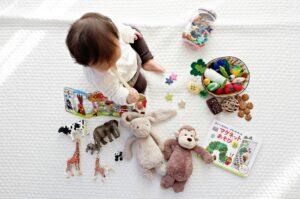Applied Behavior Analysis (ABA) is a widely used therapy for children with autism and other developmental disabilities, typically focusing on structured environments like therapy centers or homes. However, many parents find themselves facing challenges when trying to apply ABA strategies during community outings. Places like grocery stores, restaurants, and airports can be overwhelming for children due to sensory overload, unfamiliar environments, and unpredictable social situations. Fortunately, ABA principles can be adapted for these outings, helping children navigate the world more easily. Here are some practical tips for applying ABA strategies during grocery shopping, dining out, and traveling.
Grocery Shopping: Breaking It Down with ABA
A grocery store trip may seem routine for most families, but it can be a daunting experience for children with autism. The bright lights, noise, crowded aisles, and long lines can easily lead to sensory overload. ABA techniques can help break this experience down into more manageable steps and provide positive reinforcement to make grocery shopping more successful for both the child and their family.
One way to start is by preparing your child for the outing ahead of time. A visual schedule or social story can show your child what to expect during the trip. This might include arriving at the store, selecting items, waiting in line, and returning to the car. Visual schedules have been shown to help children anticipate transitions and reduce anxiety (MacDuff, Krantz, & McClannahan, 1993). These tools can help create a sense of predictability, easing your child’s worries.
Before entering the store, it’s also essential to set clear expectations. Let your child know what behaviors are expected during the trip, such as staying close to the cart or using an inside voice. Positive reinforcement can be incredibly helpful here. Offer a small reward—like a favorite snack or extra screen time—if your child meets these behavioral expectations. Reinforcement is one of the core components of ABA and can be highly effective when applied immediately after the desired behavior (Cooper, Heron, & Heward, 2020).
Another helpful ABA technique is task analysis, which involves breaking down a complex task like grocery shopping into smaller steps. You can start by teaching your child to identify items on the list, place them in the cart, and help with checkout. Each step can be reinforced with praise or tokens, helping to promote independence while reducing challenging behaviors. This strategy makes the process feel more manageable and builds your child’s skills one step at a time.
If your child becomes overwhelmed during the outing or starts to engage in problem behaviors, techniques like prompting or extinction can help. For example, if your child is about to run away, a verbal reminder to “hold onto the cart” can redirect their behavior before it escalates. Over time, as your child learns to follow the rules, you can gradually reduce the use of prompts (Cooper et al., 2020).
Dining Out: Making It Enjoyable for Everyone
Eating out at a restaurant can be stressful for children with autism due to unfamiliar food, long waiting times, and the busy nature of dining environments. However, dining out can be an enjoyable experience when ABA principles are used to help your child feel more comfortable and confident.
One strategy that can be helpful is gradual exposure. If your child finds restaurants overwhelming, start small. Perhaps the first visit could be just for a snack or drink rather than a full meal. Gradually, you can increase the length of time spent at the restaurant, helping your child become more comfortable with the setting over time (Mancil, Conroy, & Haydon, 2009).
Positive reinforcement is just as important when dining out as it is during other outings. During the meal, reinforce positive behaviors such as sitting calmly at the table or using utensils properly. The reinforcement should be specific and immediate, such as saying, “Great job waiting for your food!” or offering a sticker for using an indoor voice. Research shows that immediate reinforcement is more effective in encouraging the child to repeat positive behaviors (Kazdin, 2001).
Waiting is often the most challenging part of dining out. Long wait times can lead to boredom and frustration, making disruptive behaviors more likely. Bringing along small activities, such as a coloring book or favorite toy, can help distract your child and keep them engaged. You could also use a token system, where your child earns tokens for every few minutes of patient waiting, which they can later exchange for a reward.
Additionally, ABA techniques can be used to teach your child how to communicate appropriately in the restaurant setting. If they become frustrated or overwhelmed, they can learn to request a break or ask for their food in a calm manner. Teaching alternative communication methods, such as using picture exchange, can also help reduce challenging behaviors (Bondy & Frost, 1994).
Traveling: Turning Stressful Journeys into Learning Experiences
Whether it’s a road trip or air travel, long journeys can be especially challenging for children with autism. The extended periods of waiting, sensory overload, and unfamiliar routines can quickly overwhelm both the child and the family. Fortunately, ABA strategies can make traveling a more positive experience for everyone involved.
Creating a visual schedule for the trip can help prepare your child for the different steps involved in traveling. For instance, if you’re flying, your visual schedule could show each step from checking in to going through security, boarding the plane, and taking off. Visual schedules are an effective tool to help children anticipate transitions and reduce anxiety in new environments (MacDuff et al., 1993).
Reinforcement systems are also highly beneficial during long trips. For example, you could use a token board or reward chart to encourage positive behavior during the trip. Tokens can be earned for staying in their seat or following safety instructions and exchanged for rewards, such as extra screen time or a favorite treat. This strategy helps make the journey more engaging and provides motivation for your child to follow the expected behaviors.
For children who struggle with sensory overload, providing sensory tools like noise-canceling headphones, fidget toys, or weighted blankets can be helpful. Sensory tools can reduce anxiety and keep your child calm during overstimulating situations, such as airport crowds or the loud noise of an airplane (Bagatell, 2010).
Another common challenge during air travel is navigating airport security, which can be stressful for children with autism due to the strict procedures and sensory overload. Practicing going through security at home through role-playing can familiarize your child with the process, making it less intimidating on the actual travel day (Mancil et al., 2009).
Conclusion:
Community outings, whether they involve grocery shopping, dining out, or traveling, can present unique challenges for families with children on the autism spectrum. However, by applying ABA techniques such as task analysis, positive reinforcement, and gradual exposure, families can help their children feel more comfortable in these settings. With a bit of preparation and the use of ABA strategies, these outings can become opportunities for growth, skill-building, and enjoyable family experiences.
References:
Bagatell, N. (2010). From Fidgeting to Focus: Addressing Sensory Needs of Students With Autism in the Classroom. *Journal of Autism and Developmental Disorders*, 40(6), 745-749.
Bondy, A., & Frost, L. (1994). The Picture Exchange Communication System. *Focus on Autism and Other Developmental Disabilities*, 9(3), 1-19.
Cooper, J. O., Heron, T. E., & Heward, W. L. (2020). *Applied Behavior Analysis* (3rd ed.). Pearson.
Kazdin, A. E. (2001). *Behavior Modification in Applied Settings*. Waveland Press.
MacDuff, G. S., Krantz, P. J., & McClannahan, L. E. (1993). Teaching children with autism to use visual schedules: Effects on on-task behavior. *Journal of Applied Behavior Analysis*, 26(1), 89-97.
Mancil, G. R., Conroy, M. A., & Haydon, T. (2009). Effects of antecedent manipulations on challenging behaviors in children with autism spectrum disorders: A systematic review. *Journal of Autism and Developmental Disorders*, 39(5), 739-754.





